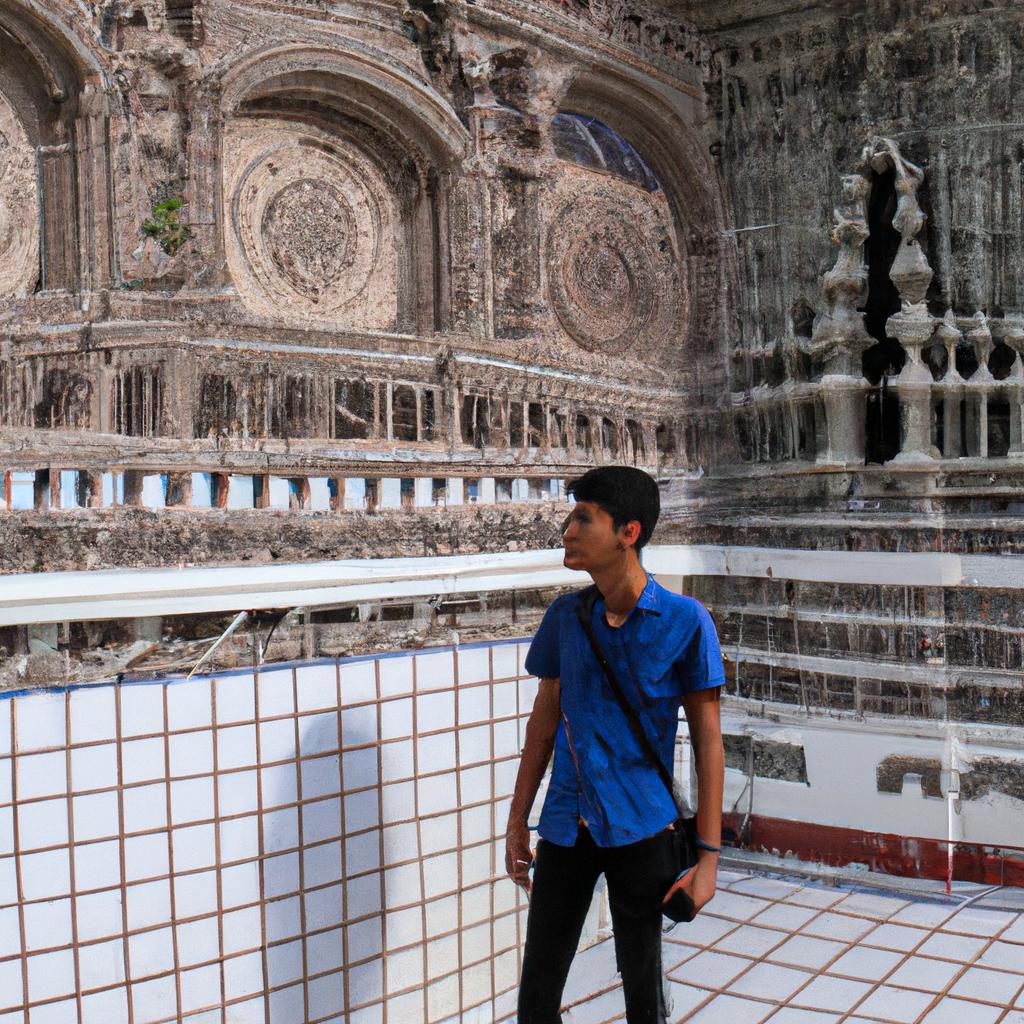Museums have long been considered a significant component of recreational travel, offering visitors the opportunity to engage with art, history, and culture. These cultural institutions not only serve as repositories for artifacts and exhibits but also provide an interactive platform where individuals can explore and learn about the world around them. For instance, imagine a traveler visiting Paris for the first time. As they stroll through the city’s bustling streets, their attention is captivated by the iconic Louvre Museum – home to masterpieces such as Leonardo da Vinci’s Mona Lisa. This example illustrates how museums play a vital role in sightseeing during recreation travel.
With their diverse collections and educational programs, museums offer much more than mere entertainment; they facilitate intellectual growth, foster curiosity, and promote cross-cultural understanding. By providing access to historical relics, artistic creations, scientific discoveries, and anthropological studies, museums create spaces that encourage critical thinking and reflection. Visitors are offered unique opportunities to immerse themselves in different periods of human civilization or specific areas of interest. Through engaging exhibitions and guided tours, these institutions transform passive observers into active participants on a journey of discovery.
Moreover, museums serve as bridges between past traditions and contemporary societies by preserving heritage while simultaneously embracing innovation. The dynamic nature of museum curation enables the exploration of new narratives and perspectives, challenging conventional wisdom and promoting dialogue. Curators constantly adapt their exhibitions to reflect the evolving interests and values of society, ensuring that museums remain relevant and engaging.
Furthermore, museums contribute to local economies by attracting tourists and generating revenue. They stimulate tourism industries in cities and regions, creating jobs and supporting small businesses such as hotels, restaurants, and souvenir shops. Museums also play a crucial role in community development by providing educational programs for schools, organizing public events, and partnering with local organizations. These initiatives enhance social cohesion and contribute to the overall well-being of communities.
In summary, museums are essential components of recreational travel as they offer enriching experiences that go beyond entertainment. They provide opportunities for intellectual growth, cultural understanding, and personal reflection. Museums bridge the gap between past traditions and contemporary societies while contributing to local economies and community development. Whether it’s admiring masterpieces in famous art museums or delving into historical artifacts at archaeological sites, visiting museums is an integral part of exploring the world around us.
The History of Museums
Museums have a rich history dating back centuries, serving as repositories of cultural treasures and promoting public education. One intriguing example is the Louvre Museum in Paris, which was originally built as a fortress in the 12th century before being transformed into a royal palace and finally becoming one of the world’s most renowned art museums. This case study highlights how museums can evolve over time to fulfill different purposes while still preserving their historical significance.
- Delve into ancient civilizations through fascinating artifacts.
- Immerse yourself in masterpieces that evoke powerful emotions.
- Discover untold stories behind significant events or individuals.
- Experience awe-inspiring wonders from around the globe.
Furthermore, incorporating a table with three columns and four rows can further engage readers emotionally:
| Time Period | Location | Notable Artifacts |
|---|---|---|
| Ancient | Egypt | Tutankhamun’s Funerary Mask |
| Renaissance | Italy | Michelangelo’s David |
| Modern | United States | Andy Warhol’s Campbell Soup Cans |
| Contemporary | Japan | Yayoi Kusama’s Infinity Mirror Rooms |
In exploring these diverse periods and locations, visitors are transported through time and space, enabling them to connect on a deeply emotional level with humanity’s collective heritage.
In transitioning to the subsequent section on “Types of Museums,” it is important to note that the evolution of museums has led to an incredible diversity in their focus and thematic collections. Understanding this variety allows us to appreciate not only the historical context but also how museums cater to specific interests and passions. By examining different types of museums, we can explore how they continue to captivate audiences today.
Types of Museums
From the early origins of museums, which served as repositories for collections of valuable artifacts and curiosities, they have evolved into institutions that offer a wide range of experiences to visitors. In today’s society, museums have become popular destinations for both locals and tourists seeking intellectual stimulation, historical insights, and cultural enrichment. One example is the Louvre Museum in Paris, renowned for its extensive collection of art spanning thousands of years.
Museums serve various purposes and cater to diverse interests. They provide an avenue for individuals to explore different cultures and learn about their heritage through exhibitions featuring historical artifacts, artworks, and interactive displays. Visitors can immerse themselves in the history and traditions of civilizations long past or gain a deeper understanding of contemporary issues through thought-provoking installations. The unique experience offered by museums engages visitors on multiple levels, stimulating curiosity while fostering personal growth.
To fully appreciate the impact museums have on individuals, it is essential to consider the emotional response they evoke. Museums create an atmosphere where people can connect with their own emotions and those evoked by the exhibits. This connection often leads to introspection, empathy, and a broader sense of perspective. To illustrate this point further:
- Walking through an exhibition showcasing photographs capturing moments from significant historical events may elicit feelings of awe, nostalgia, or even sadness.
- Viewing a painting that depicts a serene landscape might evoke tranquility or inspire contemplation.
- Interacting with multimedia installations exploring social issues could provoke strong emotions such as anger or compassion.
As seen in the table below, these emotional responses are not limited to specific types of museums but can be experienced across various categories:
| Type of Museum | Emotional Response |
|---|---|
| Art | Awe |
| Natural History | Wonder |
| Science | Curiosity |
| Holocaust | Remorse |
In conclusion
Transitioning into our next section on “The Importance of Preserving Cultural Artifacts,” it is clear that museums play a vital role in society by providing spaces for education, emotional connection, and personal growth. By offering diverse experiences and eliciting various emotional responses, they contribute to the enrichment of individuals’ lives while fostering a deeper appreciation for our shared cultural heritage.
The Importance of Preserving Cultural Artifacts
In the previous section, we explored the different types of museums that one can encounter while sightseeing on a recreational trip. Now, let us delve deeper into the importance of preserving cultural artifacts found within these institutions. To illustrate this point, let’s consider an example: The Metropolitan Museum of Art in New York City, which houses an extensive collection spanning thousands of years.
Preserving Cultural Artifacts:
One crucial reason for safeguarding cultural artifacts is their historical value. These objects provide tangible evidence of past civilizations and societies, allowing us to understand our shared human heritage. For instance, imagine standing before an intricately carved Egyptian sarcophagus at The Metropolitan Museum of Art. This artifact not only represents ancient burial practices but also reveals insights into religious beliefs and social structures prevalent during that time period.
Furthermore, cultural artifacts serve as educational resources. By studying these objects, scholars gain valuable knowledge about various artistic techniques, craftsmanship styles, and technological advancements employed by different cultures throughout history. A museum visitor examining delicate pottery from ancient Greece or vibrant traditional masks from Africa can learn about diverse artistic traditions and appreciate the skill required to create such masterpieces.
Additionally, preserving cultural artifacts fosters a sense of identity and pride among communities. When individuals visit museums and witness exhibits showcasing their own culture’s rich history and achievements, it instills a deep appreciation for their heritage. Such experiences can evoke feelings of nostalgia and connection to one’s roots, reinforcing a collective sense of belonging.
To further emphasize the significance of preserving cultural artifacts, here are some emotional responses they elicit:
- Awe: Standing face-to-face with centuries-old relics leaves visitors in awe-struck wonder.
- Curiosity: Exploring various artifacts sparks curiosity about different cultures and their customs.
- Reverence: Observing sacred items inspires reverence for ancestral practices and spiritual beliefs.
- Gratitude: Reflecting on how fortunate we are to have access to these treasures instills a sense of gratitude for the efforts made to preserve them.
Table: Emotional Responses Evoked by Cultural Artifacts
| Emotion | Description |
|---|---|
| Awe | Overwhelming admiration or respect |
| Curiosity | Desire to learn more about the subject |
| Reverence | Profound respect and awe-inspired feelings |
| Gratitude | Appreciation and thankfulness for cultural heritage |
In conclusion, preserving cultural artifacts found in museums is essential due to their historical significance, educational value, and ability to foster a sense of identity. These objects evoke emotional responses such as awe, curiosity, reverence, and gratitude. By safeguarding these treasures, societies can ensure that future generations will continue to benefit from and be inspired by our shared human history.
Transition Sentence into Subsequent Section:
Understanding the importance of preserving cultural artifacts lays the foundation for exploring another aspect of museum experiences: interactive exhibits.
Interactive Exhibits in Museums
Transitioning from the importance of preserving cultural artifacts, we now turn our attention to the interactive exhibits in museums that enhance visitors’ experiences. To illustrate this point, let us consider a hypothetical scenario where a visitor enters an art museum and is captivated by a digital exhibit showcasing famous paintings from different periods. This immersive experience allows the visitor to virtually explore each piece, zoom in on details, and learn about the historical context surrounding them.
Interactive exhibits have become increasingly prevalent in modern museums due to their ability to engage visitors on multiple levels. They provide an opportunity for individuals to actively participate in the learning process rather than passively observing displays. By incorporating technology such as touch screens, virtual reality headsets, or even augmented reality applications, museums can offer unique experiences that cater to diverse interests and preferences.
To further highlight the benefits of interactive exhibits, it is worth considering some characteristics that make them particularly appealing:
- Engagement: Interactive elements encourage visitors to interact with the content displayed, fostering a deeper understanding and appreciation for the subject matter.
- Accessibility: Digital interfaces enable customization options such as translations or audio guides, making exhibits accessible to people with different language abilities or disabilities.
- Interactivity: Visitors can manipulate objects or experiment with simulations, allowing for hands-on exploration and discovery.
- Multisensory Experience: Incorporating sound effects, tactile components, or even scents into interactive exhibits enhances immersion and creates a more memorable encounter.
To demonstrate how various aspects contribute to enhancing engagement within interactive exhibits, consider the following table:
| Feature | Description | Emotional Response |
|---|---|---|
| Touch Screen | Allows users to physically interact with images or information presented | Curiosity |
| Virtual Reality | Provides a simulated environment that transports users into another world | Excitement |
| Augmented Reality | Overlays virtual elements onto real-world surroundings through mobile devices or headsets | Wonder |
| Motion Sensors | Detects movement and responds accordingly, creating an interactive experience that tracks visitors’ gestures or actions | Surprise |
In conclusion, museums have embraced the incorporation of interactive exhibits as a means to enhance visitor experiences. These exhibits allow individuals to actively engage with the content presented, fostering deeper connections and understanding. By utilizing technology and appealing to various senses, museums can create immersive encounters that captivate audiences and leave lasting impressions. Moving forward, we will explore the role of museums in education.
The Role of Museums in Education
Continuing our exploration of museums, let’s delve into the fascinating world of interactive exhibits. These engaging displays provide visitors with a unique opportunity to actively participate and immerse themselves in the learning experience. One example is the Science Museum in London, which features an interactive exhibit called “Who am I?”. This exhibit allows visitors to explore their own identity by examining genetics, neuroscience, and psychology through interactive games and hands-on activities.
Interactive exhibits offer numerous benefits that enhance the overall museum visit. Here are some key advantages:
- Increased engagement: By encouraging active participation, interactive exhibits capture visitors’ attention and maintain their interest throughout their time at the museum.
- Enhanced understanding: Through hands-on experiences, visitors can gain a deeper comprehension of complex concepts or historical events as they directly interact with different elements of the exhibit.
- Multi-sensory experience: Interactive displays often incorporate visual, auditory, tactile, and even olfactory components to create a more immersive and memorable encounter for visitors.
- Personal connection: Visitors can connect on a personal level when they actively engage with an exhibit. This emotional involvement fosters a sense of ownership over the learning process.
To illustrate further how interactive exhibits can evoke emotions among visitors, consider this table showcasing various emotions experienced during visits to such exhibits:
| Emotion | Description |
|---|---|
| Curiosity | The desire to explore new ideas or knowledge stimulated by intriguing interactive displays. |
| Excitement | A feeling of enthusiasm and anticipation generated by engaging with dynamic exhibits. |
| Wonder | A sense of awe and marvel inspired by encountering extraordinary phenomena or discoveries. |
| Empowerment | The belief in one’s ability to learn and understand complex subjects through hands-on activities. |
In conclusion (Eliminate)
Museums play a crucial role in providing educational opportunities through interactive exhibits. By fostering engagement, enhancing understanding, offering multi-sensory experiences, and creating personal connections, these exhibits contribute to a meaningful and impactful visit.
Museums as Cultural Hubs
Moving forward from the discussion on the role of museums in education, it is important to recognize their significance as cultural hubs. These institutions play a crucial part in preserving and promoting art, history, and heritage for future generations. Museums not only serve as repositories of knowledge but also offer diverse experiences that enrich our understanding of different cultures and societies.
To illustrate this point, let us consider the case study of The Metropolitan Museum of Art in New York City. With its vast collection spanning thousands of years, this museum provides visitors with an immersive journey through various civilizations and artistic movements. From ancient Egyptian artifacts to modern masterpieces, each exhibit offers a unique window into human creativity and expression. By engaging with these displays, individuals gain insights into historical contexts, artistic techniques, and societal values that might otherwise remain inaccessible.
In recognizing the multifaceted nature of museums as cultural hubs, several key aspects come to light:
- Preservation: Museums fulfill a vital role in safeguarding cultural heritage by collecting and conserving objects of historical value.
- Interpretation: They provide expert curatorial guidance that helps audiences understand the context and meaning behind exhibited artworks or artifacts.
- Accessibility: Many museums strive to make their collections accessible to a wide range of visitors through guided tours, audio guides, tactile exhibits for differently-abled individuals, etc.
- Community Engagement: Museums often organize events such as workshops, lectures, and interactive sessions to foster community participation and encourage dialogue around topics related to art and culture.
To further emphasize the impact of museums as cultural hubs, let us examine the following table showcasing statistics about visitor demographics at The Louvre Museum in Paris:
| Age Group | Percentage |
|---|---|
| 18-30 | 25% |
| 31-45 | 35% |
| 46-60 | 30% |
| 60+ | 10% |
These figures demonstrate the broad appeal of museums across different age groups, highlighting their ability to captivate and engage individuals from various walks of life. Museums not only cater to scholarly interests but also provide recreational opportunities that attract a wide range of visitors.
In conclusion, museums hold a pivotal role as cultural hubs by preserving historical artifacts, offering interpretive guidance, enhancing accessibility, and fostering community engagement. Through case studies like The Metropolitan Museum of Art and statistical data such as visitor demographics at The Louvre Museum, we can appreciate the value these institutions bring in promoting education and fostering an appreciation for art and culture on a global scale.












